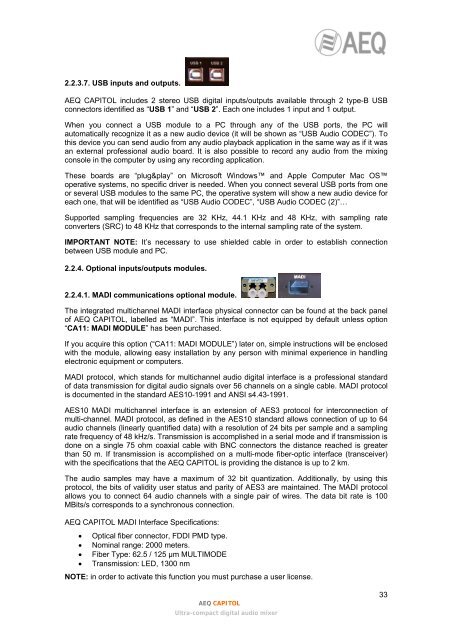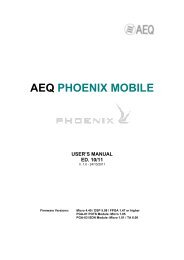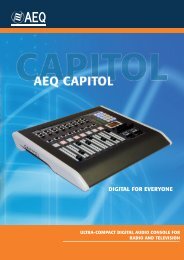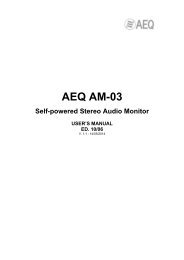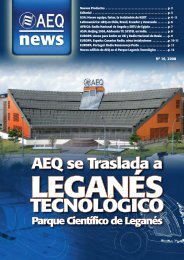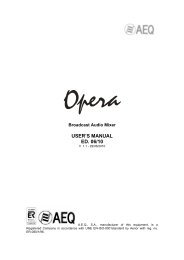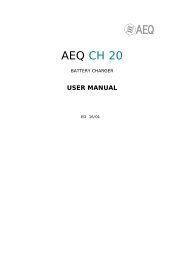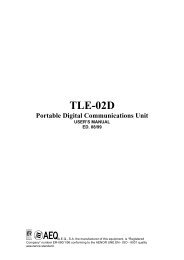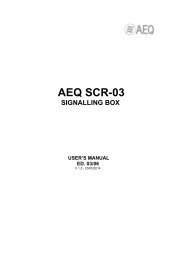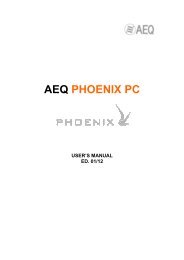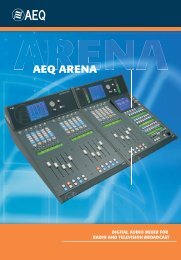Manual - AEQ International
Manual - AEQ International
Manual - AEQ International
Create successful ePaper yourself
Turn your PDF publications into a flip-book with our unique Google optimized e-Paper software.
2.2.3.7. USB inputs and outputs.<strong>AEQ</strong> CAPITOL includes 2 stereo USB digital inputs/outputs available through 2 type-B USBconnectors identified as “USB 1” and “USB 2”. Each one includes 1 input and 1 output.When you connect a USB module to a PC through any of the USB ports, the PC willautomatically recognize it as a new audio device (it will be shown as “USB Audio CODEC”). Tothis device you can send audio from any audio playback application in the same way as if it wasan external professional audio board. It is also possible to record any audio from the mixingconsole in the computer by using any recording application.These boards are “plug&play” on Microsoft Windows and Apple Computer Mac OSoperative systems, no specific driver is needed. When you connect several USB ports from oneor several USB modules to the same PC, the operative system will show a new audio device foreach one, that will be identified as “USB Audio CODEC”, “USB Audio CODEC (2)”…Supported sampling frequencies are 32 KHz, 44.1 KHz and 48 KHz, with sampling rateconverters (SRC) to 48 KHz that corresponds to the internal sampling rate of the system.IMPORTANT NOTE: It’s necessary to use shielded cable in order to establish connectionbetween USB module and PC.2.2.4. Optional inputs/outputs modules.2.2.4.1. MADI communications optional module.The integrated multichannel MADI interface physical connector can be found at the back panelof <strong>AEQ</strong> CAPITOL, labelled as “MADI”. This interface is not equipped by default unless option“CA11: MADI MODULE” has been purchased.If you acquire this option (“CA11: MADI MODULE”) later on, simple instructions will be enclosedwith the module, allowing easy installation by any person with minimal experience in handlingelectronic equipment or computers.MADI protocol, which stands for multichannel audio digital interface is a professional standardof data transmission for digital audio signals over 56 channels on a single cable. MADI protocolis documented in the standard AES10-1991 and ANSI s4.43-1991.AES10 MADI multichannel interface is an extension of AES3 protocol for interconnection ofmulti-channel. MADI protocol, as defined in the AES10 standard allows connection of up to 64audio channels (linearly quantified data) with a resolution of 24 bits per sample and a samplingrate frequency of 48 kHz/s. Transmission is accomplished in a serial mode and if transmission isdone on a single 75 ohm coaxial cable with BNC connectors the distance reached is greaterthan 50 m. If transmission is accomplished on a multi-mode fiber-optic interface (transceiver)with the specifications that the <strong>AEQ</strong> CAPITOL is providing the distance is up to 2 km.The audio samples may have a maximum of 32 bit quantization. Additionally, by using thisprotocol, the bits of validity user status and parity of AES3 are maintained. The MADI protocolallows you to connect 64 audio channels with a single pair of wires. The data bit rate is 100MBits/s corresponds to a synchronous connection.<strong>AEQ</strong> CAPITOL MADI Interface Specifications:• Optical fiber connector, FDDI PMD type.• Nominal range: 2000 meters.• Fiber Type: 62.5 / 125 µm MULTIMODE• Transmission: LED, 1300 nmNOTE: in order to activate this function you must purchase a user license.<strong>AEQ</strong> CAPITOLUltra-compact digital audio mixer33


